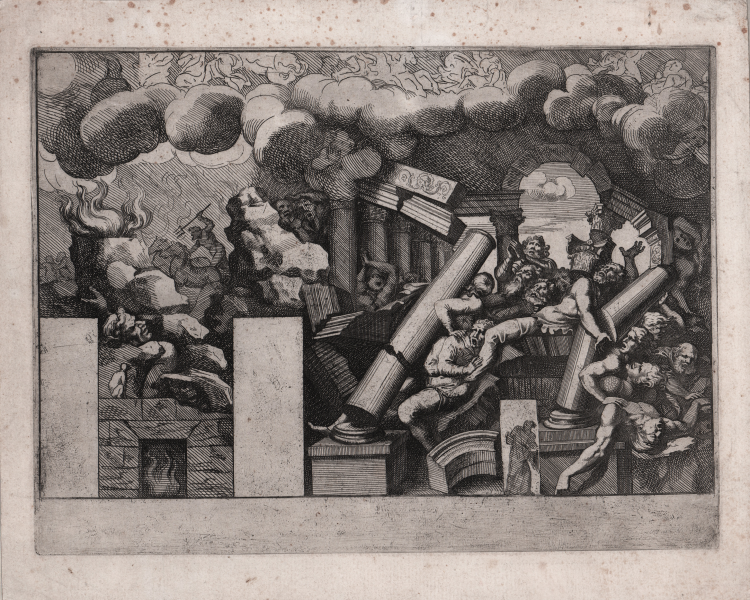




| Reference: | S21435 |
| Author | Pietro Santi BARTOLI |
| Year: | 1680 ca. |
| Measures: | 282 x 194 mm |



| Reference: | S21435 |
| Author | Pietro Santi BARTOLI |
| Year: | 1680 ca. |
| Measures: | 282 x 194 mm |
Etching, 1680 circa, unlettered.
Giants crushed by rocks and the falling columns of the temple, clouds of smoke above, Poseidon in his chariot to left in the background, two spaces at left for doorways,
From 'Giove che fulmina li giganti', after the frescoes on the ceiling of the Sala dei Giganti designed by Giulio Romano for the Palazzo del Te, Mantua
A fine impression of the first state of two, before the number, printed in contemporary laid paper, with margins, light foxing otherwise in very good conditions.
“Bartoli's series is an interesting and important testimony to the ‘capricious ingenious Giulio,’ who in this cycle of frescoes perhaps wished to allude to the act of homage and submission rendered by Federico Gonzaga to Emperor Charles V on the occasion of his second visit to Mantua in 1532, while at the same time providing a warning to anyone wishing to rebel against a higher power. The Fall of the Giants was also associated with the punishment of Francesco Gonzaga da Calvisano, husband of Isabella Boschetti who was made to be killed by Federico and the other present rebels. The virtues that govern human relations, represented in the Emperor's chamber, would thus be contrasted with the temerity and presumption of the Giants, the sons of Gaea who having dared to climb Olympus are struck by Jupiter's thunderbolts that cause their death and eternal suffering as appears on the west wall reproduced in Bartoli's penultimate print where the Cyclopes annihilated by Neptune under Mount Etna are represented, which in the illusionistic effect of the Hall incorporates the fire developed by the fireplace” (cfr. S. Massari, Giulio Romano pinxit et delineavit, p. 277).
Bibliografia
S. Massari, Giulio Romano pinxit et delineavit, p. 273, 270 I/II.
Pietro Santi BARTOLI (Perugia 1635 – Roma 1700)
|
Pietro Santi Bartoli was an Italian engraver, draughtsman and painter. Bartoli was born in Perugia in 1635 and died in Rome on 7 November 1700. According to tradition, he was a pupil of Poussin. Known primarily as a draughtsman, engraver and painter, he also served Christina, Queen of Sweden, as an antiquarian. He was responsible for several publications on Roman sculpture and works of art, such as the Admiranda romanarum antiquitatum of 1693. In 1680, he produced engravings of the Nasonii tomb paintings in Le pitture antiche del sepolcro de Nasonii nella Via Flaminia; this work included a commentary by Bartoli's friend, Giovanni Pietro Bellori (1613-96), the leading theorist of seventeenth century classicism.
|
Pietro Santi BARTOLI (Perugia 1635 – Roma 1700)
|
Pietro Santi Bartoli was an Italian engraver, draughtsman and painter. Bartoli was born in Perugia in 1635 and died in Rome on 7 November 1700. According to tradition, he was a pupil of Poussin. Known primarily as a draughtsman, engraver and painter, he also served Christina, Queen of Sweden, as an antiquarian. He was responsible for several publications on Roman sculpture and works of art, such as the Admiranda romanarum antiquitatum of 1693. In 1680, he produced engravings of the Nasonii tomb paintings in Le pitture antiche del sepolcro de Nasonii nella Via Flaminia; this work included a commentary by Bartoli's friend, Giovanni Pietro Bellori (1613-96), the leading theorist of seventeenth century classicism.
|